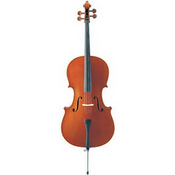Your shopping cart is currently empty.
If you have not already done so, you can login to your account to see any items that may be saved in your cart. Once logged in, you may also add items to the cart that you saved previously to your wishlist.
Instrument Overview

The cello is a member of the string instrument family. The cello is usually played sitting down.
Cellos are available in fractional sizes (1/4, 1/2, etc) to accommodate young students. Eventually most people end up playing a full-size cello.
These are general guidelines for help in determining the correct instrument size. The best option is to have the teacher size the student, and always defer to the teacher's judgment in sizing. It is important for the player to be comfortable to avoid issues that may develop over time from playing an improperly sized instrument.
To size an instrument, the player should sit so that the knees are bent at a 90 degree angle. The instrument should rest such that the upper rim rests on the sternum and the left knee contacts the curve below the lower bout corner. The C-string peg should be near the left ear, with the neck a few inches from the shoulder, and the left hand should be able to reach both ends of the fingerboard with ease. The first and fourth fingers of the left hand should be able to comfortably span a major third on the D string.
| Cello Size | Height | Arm Length | Finger Span | Player's Age |
|---|---|---|---|---|
| 1/16 | under 4 years old | |||
| 1/10 | 4 to 5 years old | |||
| 1/8 | 3.5 to 4 feet | 4 to 6 years old | ||
| 1/4 | 3.5 to 4 feet | 18" to 20" | 3" to 4" | 6 to 8 years old |
| 1/2 | 4 to 4.5 feet | 20" to 22" | 4" to 5" | 8 to 10 years old |
| 3/4 | 4.5 to 5 feet | 22" to 24" | 5" to 6" | 10 to 12 years old |
| 4/4 | 5+ feet | 24" and up | 6"+ | 12 years and older |
7/8 size cellos are also available by special request. These are sometimes used by smaller adults or people with small hands.
Other Resources
Cello Facts